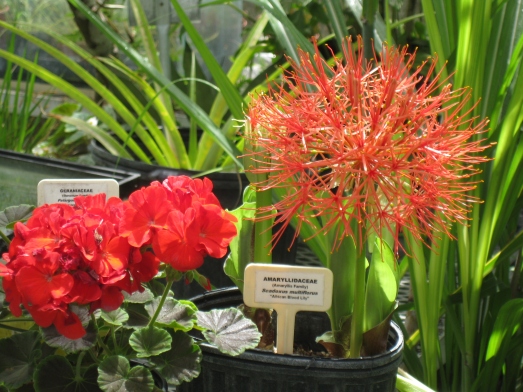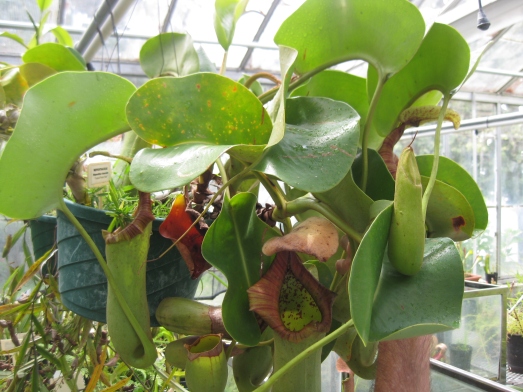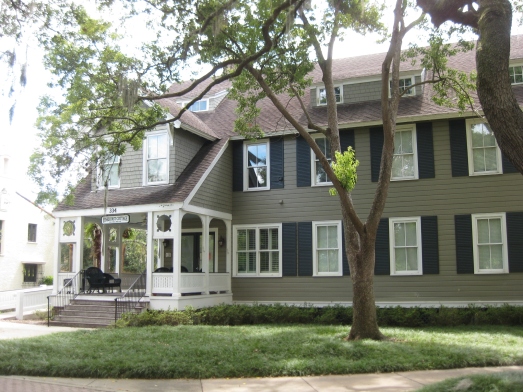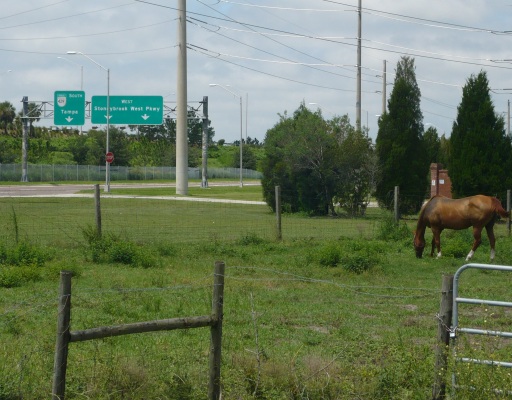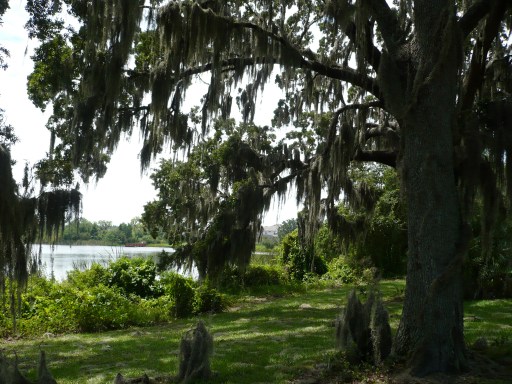
Me, inside the Osceola vault.
I used to work at the bookstore with a crazy lady named Becky. She’s a Florida native and has cousins around every corner, and she recently wrote a book about Umatilla for Arcadia Press describing the history of the small Lake County community, much of which was perpetrated by her extensive family. She reads my blogs and got in touch with me last week after reading my latest Oakland blog, and suggested a trip up to Geneva, a very small town in northern Seminole County.
“I want to find my great great great grandmother in the Geneva cemetery,” she said.
“Well, that should be easy,” I said. “She can’t have wandered very far.”
Her name was Mary Ann Higginbotham Hart, and she was born in 1817 and died in 1906. Our goal was to find the lady’s final resting place and then go looking for the Osceola vault– a bank vault used by the vanished timber mill town of Osceola to store money and valuables. I had read about it and seen it on Google Earth, and realized that I’d driven right past it months ago without noticing because a guy wearing sunglasses and a tractor waved at me as I rounded that corner on my way to finding the end of lonely East Osceola Road.
Like myself, Becky is game for getting into possibly precarious situations; also like me, she has a positive attitude guaranteed to get her out of tight places. Today, the two Pollyannas (one somewhat bald and hard of hearing, one talking in a loud twang) set out on a jaunt.
The Geneva area is country. You’ll see lots of indications that the natives respect Republicans, the Baptist faith, and fried pork rinds. (You usually find them all in one place, like a church cellar.)

A Geneva farmstead.
After a few well-marked turns, we found cemetery Road, which took us directly east into the Geneva Cemetery. It’s certainly a colorful and interesting cemetery, decorated in spots as if the surviving families were expecting the circus to pull into town any minute, but it’s actually a happy place. You won’t be set upon by officious yuppie women in blue suits wielding sharp clipboards, yelling because you placed red, white and blue plastic carnations into a vase. Here, it seems like anything goes:



We wandered up and down the rows looking for Mary Ann, occasionally calling out to one another across the rural stillness. Sometimes we’d confer with Becky’s phone, calling up the Internet for clues as to where she was located. There were plenty of Harts and Prevatts and Raulersons, all intricately connected (like I said, Becky has cousins all over the place, including underfoot)… but no Mary Ann.

Though it was well before noon, it was very warm, and soon a bank of fluffy gray clouds rained on us, considerably cooling things off. Was Mary Ann encouraging us to keep looking? Who can say? I finally decided that we should split up and each take half of the small cemetery, conscientiously reading tombstones until we found her, by golly! And we marched to the front (we’d started in back) and, sure enough, Becky found her even before we started looking hard, located right along the main road coming in. Yay! There was Becky’s great-great-great grandmother. Becky felt a keen sense of connection, and an ever more acute tie to the past, something which all native Southerners live for. never mind about the present– they dream they dwell in marble halls.

And now it was time to find the Osceola vault. Now, I knew what it looked like from online photos, but still: I had to see it for myself. This was ancient (for Florida) history, just laying out on a road somewhere for all to see.

We passed the Geneva Methodist church on our way out of town, which I wanted to enter but, as a snakeskin-booted young man informed me, services were being held: I could hear the preacher hollering inside.
Along the road heading into the country is a historical marker telling about King Philipstown:


Personally, I love the line “the Indians were repulsed… ” Though they mean “vanquished,” I like to think it meant that the Indians were repulsed by the awful things the white settlers were doing when they arrived. This marker is located at the entrance to a trail which we walked down for a minute or so: absolutely stunning.


Just a little bit further down the road we found… the Osceola vault! This is the only surviving relic of the old mill town of Osceola, which flourished from 1916 to 1940. (I read historical markers, or else I would be hopelessly confused.) The timber company’s valuable assets were stored here, well away from the “town” which was located a few miles south next to Geneva.

Of course I had to climb INTO the vault, but had to cross those weeds that you see. Now I understand why the English all carry walking sticks, which must be hell on the London subways, but I can see where they would come in handy in a place like this. I pressed on, flattening weeds and expecting snakes, spiders, and assorted vermin to leap at me, but nothing happened.
There’s no money inside the vault anymore– only what money can buy:

Above the entryway, which I noticed when I was well inside, were these clumps of web looking disturbingly occupied. I had to pass beneath them, naturally, to get back outside into the safety of the weeds…

At this point any normal people who have had their fill and started home, but I’d mentioned that I’d gone as far as I thought I could along East Osceola Road that last time, and of course Becky suggested that we go and see if it went further; according to the map, the road curved north, then west, and then possibly south to Highway 46 out of Sanford. We had to go and see.
A link to the Geneva Wilderness Area.
Here’s what the smooth black top turned to soon after the Osceola vault:

Yes, there’s room for one vehicle; SOMEONE would have the right of way if two vehicles met, and we had a feeling it would be one of the natives.
We were charmed by a road called Gator Growl, and here’s what was almost at the end of it: the St. John’s River. (A vehicle met us face to face, but he turned off into a sideway and we pressed on.)

Somewhere along here was a sign that said “Residents Only” to anyone, mainly us, desiring to go further. If any patrol car could be found in this remote place, and the occupant decided to stop and grill us, we were ready with excuses:
“We’re looking at property.”
“There’s a cabin for sale that we want to look at.”
“We’ve been invited to a baptizing along the river.”
“We’ve been invited to a hanging, hopefully not ours.”
Nobody stopped us, and we drove on and on and ON, and it was beautiful and wild. Becky took the following three pictures:



Did we make jokes about furniture and household items made from cypress knees? Yes.
We went just past B.F. Egypt, and decided to not go much further– the map, upon closer inspection, indicated that the road eventually ended a short ways ahead. We turned around, precariously but carefully on the one-track trail, and got back to a turn– and found ourselves faced by three vehicles of varying sizes, all of which wanted to go through. There was lots of (wary) smiling and (wary) waving and assorted (wary) country-friendly hand signals until the four drivers decided which way to go; it was like a chess game but eventually we sorted it out and we were on our way when Becky spied easy access to the river: up a short rise, past an outhouse which she was tempted to use, and then down a slope to the St. John’s. She parked, we set out and, just to make sure we meant no harm, Becky started calling out: “Hello??? Hello??? Hello???” her voice echoed through the loneliness, but nobody appeared except for the family of seven, each of whom had three eyes and wore clothes made from human skin. Kidding! Nobody was home, but Becky elected to not use the facilities.

Have you ever known a woman to pass facilities without availing herself of them? Becky did!
We eventually ended up back in Geneva by way of another street, and we came across the Radley House. Well, it’s the closest to the Radley House that I’ve ever seen in real life…

After all this rural, I treated to lunch at Cavallari Gourmet in Oviedo. It was an odd though delicious jolt into the present after all the past we had immersed ourselves in. And many thanks to Becky for driving all that way; it was interesting talking during one of these little trips, as I am practically almost always off on my own. And Becky and all her cousins were fine company.









